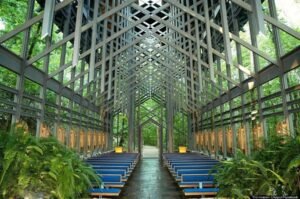Biophilic design in Architecture covers all principles of interaction between human beings and nature. It creates a vibrant environment with all the elements of nature into the habitable spaces. Looking at the harsh environmental conditions in our urban areas, there is not enough fresh air and natural beauty even after having plenty of public open spaces and landscaping.
Designing public parks and other natural escapes in and around a city is not a solution to connecting with nature anymore. Understanding the increasing urban sprawl, it is impractical to take humans towards nature and so getting nature in the cities is the working solution. Creating healthy habitats by Biophilic designs will ensure good health, physical and mental well-being and connect people with their environment.
There are multiple approaches towards building a naturally vibrant habitat in any commercial, residential or public space. Some of the ways may include directly inviting plants, water, natural light, and wind flow and natural materials into the building. On the other hand using passive features like colors, materials, textures and elements of natures into our planning process. Both options allow a simple but thoughtful approach towards connecting with nature to boost productivity and health in our urban spaces.

Incorporating transitional spaces:
The transitional spaces are very often ignored on a wider scale while focusing on habitable spaces. There is an understated notion about the passages, walkways and the in-between spaces of our buildings. These can be converted into naturally designed and accommodated islands which allow people to spend minutes into environmental escapes.
Make plants your best friends:
One of the best ways to start a conversation with nature is to plan dedicated spaces for plants into the indoor volumes. There are two benefits to this practice:
- Indoor plants demand a specific amount of sunlight and water and wind flow to grow and stay healthy. This will automatically improve the passive design features of our buildings.
- There is a positive psychological impact that plants create on human behavior, indirectly bonding with people in the work-space as their colleagues!
Create indoor ecosystems:
To achieve a relaxed state of mind and increase productivity, harmonizing nature and modern designs with the incorporation of multiple elements of ecosystems have proven to be effective for years now. It can include the use of natural building materials and creating green corridors and walls. Using intricate features like water, plants, earth and adjusting light with wind can simply create a natural abode.
Experiment with natural materials:
Stone and wood have been a part of Architectural design for years but it has gained more relevance when designing Biophilic spaces. Minimal, white and clear commercial or residential spaces tend to form a repetitive picture in the people’s minds that becomes a routine. Adding a hint of naturally obtained materials like wood, stone or sand textures in interior spaces has a strong visual connection with the environment because of their capacity to fabricate various inbuilt patterns.
How is Biophilic design different than sustainable design?
The main criteria that differentiate sustainability from Biophilic design are the use of active or passive products to achieve a certain stage of sustainable buildings. Sustainability in architecture is based on various calculated factors to reduce physical energy needs and carbon footprint of the buildings to function better and have a less harmful environmental impact. There are no calculated parameters while opting for Biophilic designs for our spaces but there exist certain rated technical calculations to approach sustainable design.

The biophilic design clearly invites the physical nature and its elements into your spaces to increase mental as well as physical activity of human beings not necessarily depending on any products to achieve so. The biophilic design creates an experiential journey within your spaces to increase an emotional connection with the environment.
One of the most famous buildings that would fall under a Biophilic design is ‘Fallingwater’ by Architect Frank Lloyd Wright which literally sits in an ecosystem without disrupting any flow. It very gently merges with the surrounding environment rather than making nature a part of itself. There is a wise choice of materials and their orientation.
Biophilic designs can also be imagined on a larger scale in urban areas as it has been adopted in the Gardens by the Bay in Singapore. Although it is a great example of landscape architecture, this exceptional design by Grand Associates gives its spectators an experience that occasionally makes them aware of their presence inside the space.



